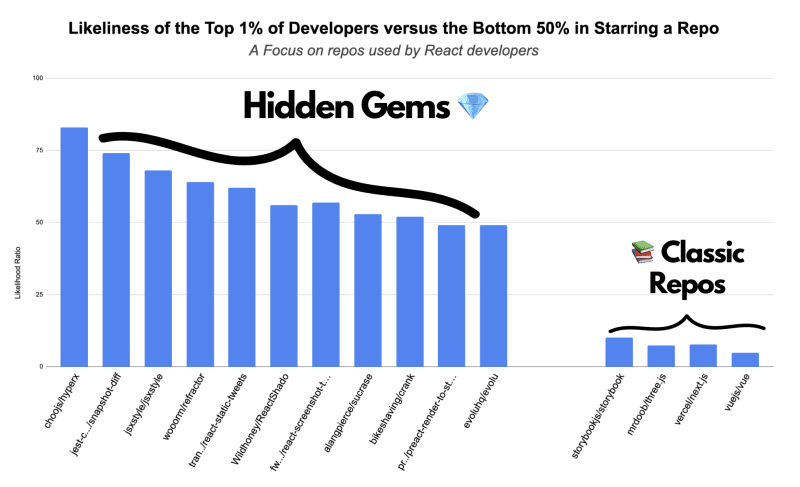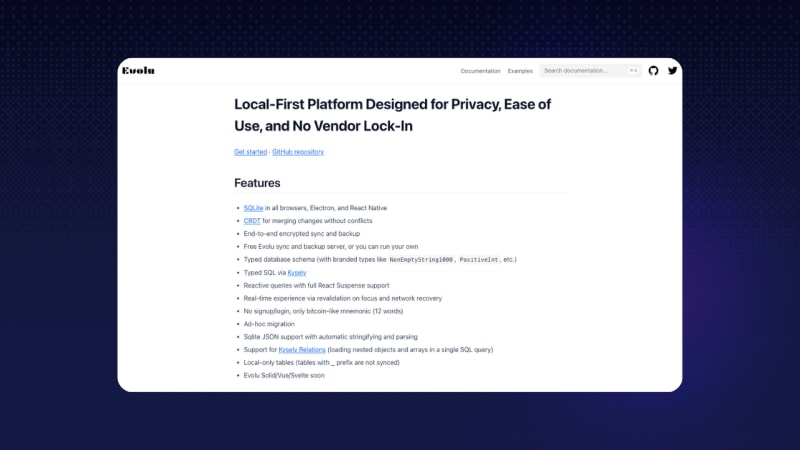

📚 8 repos used by the top 1% of React devs 🏆
source link: https://dev.to/quine/8-repos-used-by-the-top-1-of-react-devs-2758
Go to the source link to view the article. You can view the picture content, updated content and better typesetting reading experience. If the link is broken, please click the button below to view the snapshot at that time.

Hi there 👋
Today, let's look into 8 React repos that the top 1% of developers use (and those you have likely never heard of).
Ready?

How do we find the repos used by the top 1% of devs? 🔦
Our story behind how we find what the best developers use is anchored in a lot of data digging and some non-trivial modelling.
Now, at Quine, we rank developers based on their DevRank.
In simple terms, DevRank uses Google’s PageRank algorithm to measure how important a developer is in open source based on their contributions to open source repos.
To create this list, we looked at the repos that the top 1% have starred. 🌟
Then, we calculated the likelihood that the top 1% of developers will star a repo compared to the likelihood that the bottom 50% won’t.
Lastly, after a little hand-picking, we found the 8 repos below. 👇
These repos will be particularly useful when you want to build cool web apps.
If you are interested in working on building small apps, and you enjoy the applied AI side, we recommend you check out Creator Quests, an open-source challenge that rewards developers for creating cool GenerativeAI apps with ChatGPT, Claude, Gemini and more. 🙃 💰
The latest Creator Quest challenges you to build developer tools using Generative AI. To participate, simply sign up to Quine and head to Quests.
The current prize pool is $2028, and it will increase as more participants join! Click on the image below and give it a try! ⬇️
🪮 jsxstyle/jsxstyle
No more JS to CSS jumping
Why should you care? In web development, with React or Preact, you must style your components (like buttons, menus, etc.). Traditionally, this is done using separate CSS files or complex styling systems, which can be time-consuming and cumbersome to manage. jsxstyle simplifies this process by letting you define styles directly within your JavaScript code, alongside the components. In other words, this means you would no longer need to jump between JS and CSS files.
Set up: npm install jsxstyle
Example use case: Your code can look like this. 👇
<Row padding={15}>
<Block
backgroundColor="#EEE"
boxShadow="inset 0 0 0 1px rgba(0,0,0,0.15)"
borderRadius={5}
height={64}
width={64}
marginRight={15}
backgroundSize="contain"
backgroundImage="url(http://graph.facebook.com/justinbieber/picture?type=large)"
/>
<Col fontFamily="sans-serif" fontSize={16} lineHeight="24px">
<Block fontWeight={600}>Justin Bieber</Block>
<Block fontStyle="italic">Canadian</Block>
</Col>
</Row>
https://github.com/jsxstyle/jsxstyle
💨 alangpierce/sucrase
A super-fast alternative to Babel
Why should you care? Babel is a widely used tool in web development that converts modern JavaScript code into a format that older browsers can understand. Sucrase is a faster alternative to Babel.
Set up:
yarn add --dev sucrase # Or npm install --save-dev sucrase
node -r sucrase/register main.ts
Example use case: Sucrase can be called from JS directly:
import {transform} from "sucrase";
const compiledCode = transform(code, {transforms: ["typescript", "imports"]}).code;
https://github.com/alangpierce/sucrase
🎨 wooorm/refractor
I colour your web page code to make your life easier
Why should you care? Refractor is important because it allows you to add highlighting, which enhances readability to your project; especially when you add code snippets to a web application. It allows you to express code in more than 270 programming languages and is especially useful in areas where traditional HTML-based highlighting is not ideal, such as CLI forms.
Set up: npm install refractor
Example use case:
import {refractor} from 'refractor'
const tree = refractor.highlight('"use strict";', 'js')
console.log(tree)
Yields:
{
type: 'root',
children: [
{
type: 'element',
tagName: 'span',
properties: {className: ['token', 'string']},
children: [{type: 'text', value: '"use strict"'}]
},
{
type: 'element',
tagName: 'span',
properties: {className: ['token', 'punctuation']},
children: [{type: 'text', value: ';'}]
}
]
}
https://github.com/wooorm/refractor
🐦 transitive-bullshit/react-static-tweets
Your best choice for adding Tweets on your website.
Why should you care? Adding Tweets to your website is a cool feature you see on many landing pages. React Static Tweets is important because it provides a highly efficient way to embed tweets in your web projects, offering much faster load times and better performance compared to Twitter's standard embedding method.
Set up:
npm install react-static-tweets static-tweets date-fns
# or
yarn add react-static-tweets static-tweets date-fns
Example Use Case:
import React from 'react'
import { fetchTweetAst } from 'static-tweets'
import { Tweet } from 'react-static-tweets'
const tweetId = '1358199505280262150'
export const getStaticProps = async () => {
try {
const tweetAst = await fetchTweetAst(tweetId)
return {
props: {
tweetAst
},
revalidate: 10
}
} catch (err) {
console.error('error fetching tweet', err)
throw err
}
}
export default function Example({ tweetAst }) {
return <Tweet ast={tweetAst} />
}
https://github.com/transitive-bullshit/react-static-tweets
🖨️ preactjs/preact-render-to-string
Render your components in HTML
Why should you care?
"preact-render-to-string" is a tool that helps websites load faster and display better in search engines. Websites built using JS frameworks like Preact take a while to display content because the browser must run JavaScript first. This repository does the heavy lifting on the server side by converting the components into ready-to-use HTML. So when someone visits the website, they will see the content immediately, even if the Internet is slow.
Set up: npm install preact-render-to-string
Example use case:
import { render } from 'preact-render-to-string';
import { h, Component } from 'preact';
/** @jsx h */
// Classical components work
class Fox extends Component {
render({ name }) {
return <span class="fox">{name}</span>;
}
}
// ... and so do pure functional components:
const Box = ({ type, children }) => (
<div class={`box box-${type}`}>{children}</div>
);
let html = render(
<Box type="open">
<Fox name="Finn" />
</Box>
);
console.log(html);
// <div class="box box-open"><span class="fox">Finn</span></div>
https://github.com/preactjs/preact-render-to-string
🏆 bikeshaving/crank
The Just JavaScript Framework
Why should you care? In a traditional web framework like React, web components are configured once and changed only when explicitly specified. They look like static images that need to be updated manually. Crank.js changes this by allowing the widget to update itself in response to new data, similar to a news ticker refreshing with new news. This is especially useful for web applications that manage real-time data such as live sports scores or product updates.
This repo would need more people migrating to this to gain traction, but it is still a very cool repo to keep an eye on. 👀
Set up: $ npm i @b9g/crank
Example Use Case:
import {renderer} from "@b9g/crank/dom";
function Greeting({name = "World"}) {
return (
<div>Hello {name}</div>
);
}
renderer.render(<Greeting />, document.body);
https://github.com/bikeshaving/crank
🎯 evoluhq/evolu
I'm a local-first kind of person
Why should you care? Web applications typically rely on storing user data on servers, which requires constant internet connectivity and raises concerns about privacy and data security. This server-based approach also means slower performance and potential data loss if the server goes down or a company ceases operations.
Evolu introduces a "local-first" approach, where data is stored directly on the user's device. This means your applications can work offline, have faster access to data, and offer enhanced privacy and security. This will be useful if you’re building offline Chrome/browser apps.
Set up: npm install @evolu/react
To start using it, you can find this great guide here.
https://github.com/evoluhq/evolu
📸 jest-community/snapshot-diff
I compare your components and highlight the difference
Why should you care? When testing React components or other JavaScript values, developers typically compare entire states or outputs. This means dealing with large chunks of data where finding specific changes is like searching for a needle in a haystack. Snapshot-diff is a focused comparison tool that allows you to take two different states of a component (or any two JavaScript values) and directly compare them, highlighting only the differences.
This is especially helpful in testing React components, as it pinpoints exactly what changed between two states, making it much easier to identify and understand the impact of your code changes.
Set up: yarn add --dev snapshot-diff
Example Use Case: Default Jest Matcher
const snapshotDiff = require('snapshot-diff');
test('snapshot difference between 2 strings', () => {
expect(snapshotDiff(a, b)).toMatchSnapshot();
});
const React = require('react');
const Component = require('./Component');
test('snapshot difference between 2 React components state', () => {
expect(
snapshotDiff(<Component test="say" />, <Component test="my name" />)
).toMatchSnapshot();
});
https://github.com/jest-community/snapshot-diff
I hope these discoveries are valuable to you and will help build a more robust React toolkit!⚒️
If you want to leverage these tools today to earn rewards, we have just launched a challenge to build a developer tool using Generative AI.
If that's of interest, log into Quine and discover Quests! 💰

Lastly, please consider supporting these projects by starring them. ⭐️
PS: We are not affiliated with them. We just think that great projects deserve great recognition.
See you next week,
Your Dev.to buddy 💚
If you want to join the self-proclaimed "coolest" server in open source 😝, you should join our discord server. We are here to help you on your journey in open source. 🫶
Recommend
About Joyk
Aggregate valuable and interesting links.
Joyk means Joy of geeK









